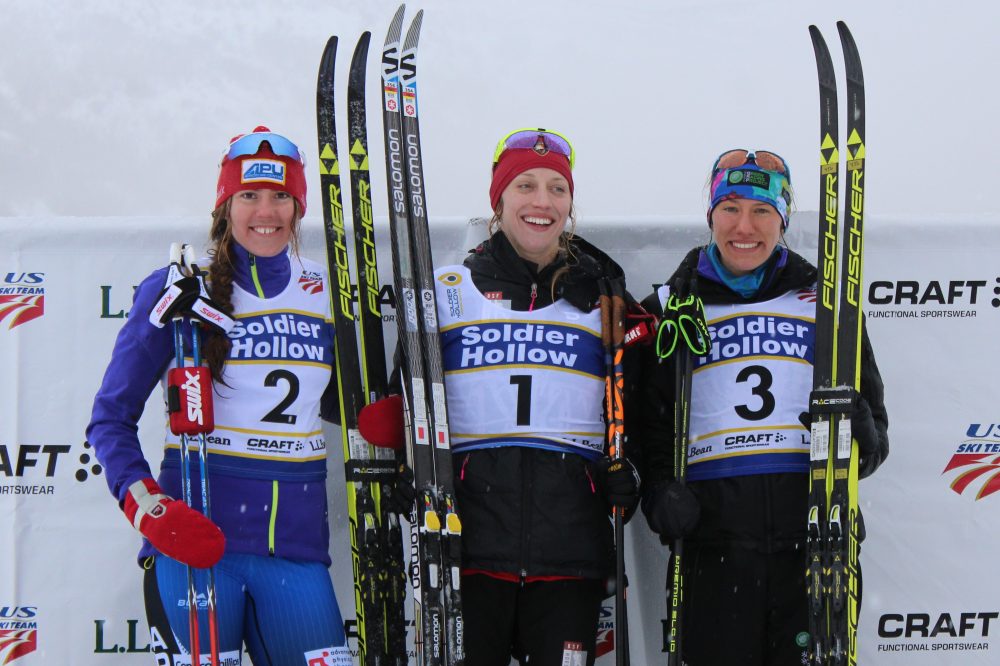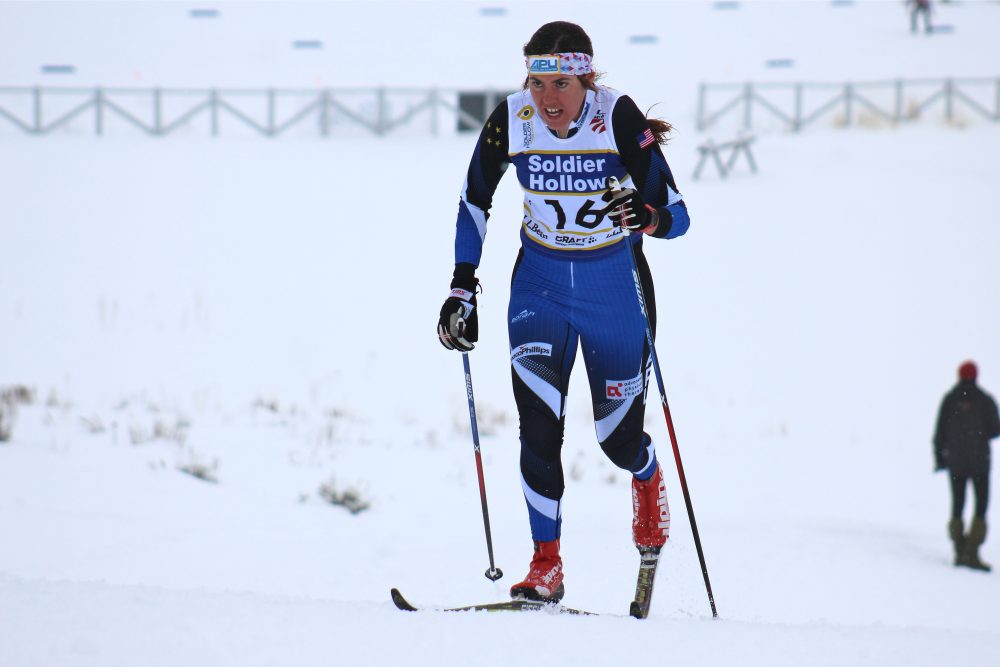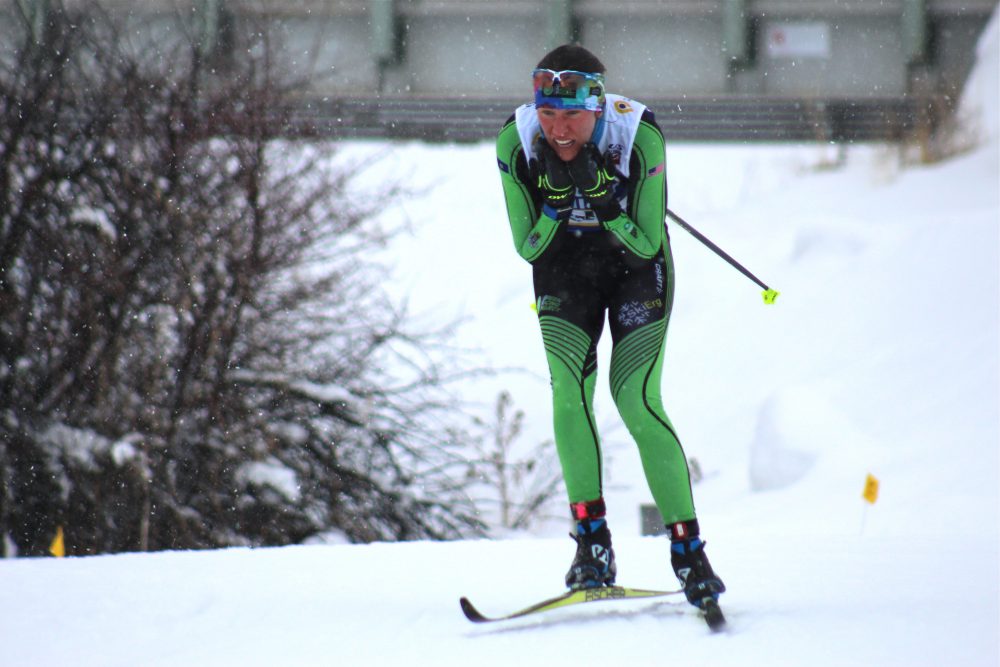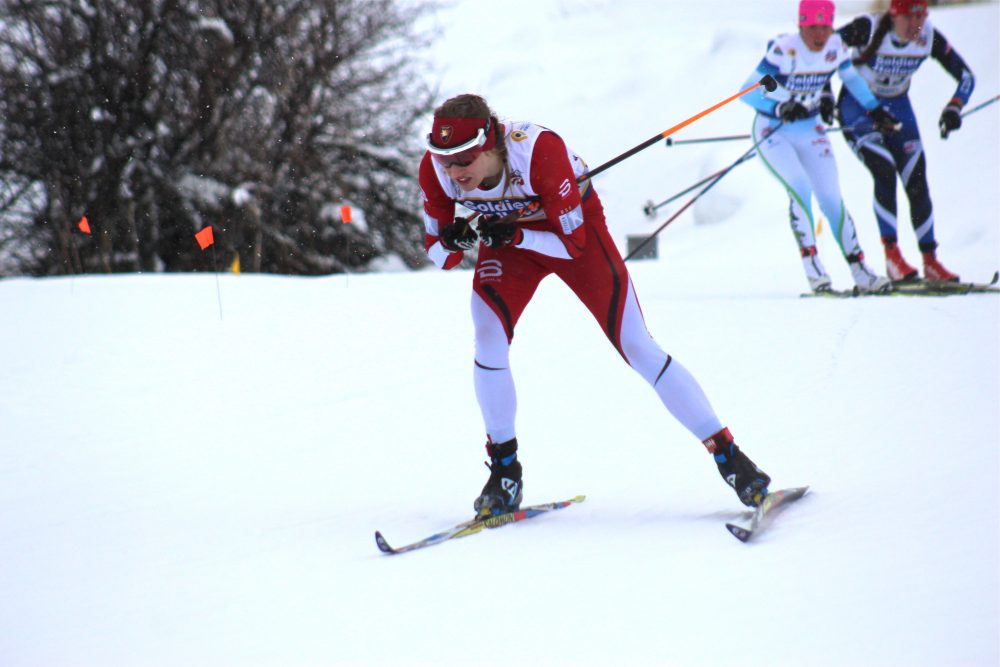
MIDWAY, Utah — There was a dampness in the room, and an odor that clung to the walls like plastic. Yet athletes continued to enter, with one after another pulling open the doors to the Soldier Hollow venue (SoHo) volunteer building. Once inside, many made a beeline for the race committee’s makeshift front desk. Race bibs and start lists, however, were not what they sought.
Close to an hour had passed since the final female starter had finished Sunday’s 2017 U.S. Cross Country Championships classic sprint qualifier; most bibs were stretched inside out over warmup jackets and start lists tucked away in side pockets.

Athletes who did work their way to the race committee counter requested something else: trash bags.
Stepping outside and surveying the stadium at U.S. nationals, it didn’t take long to realize why.
Rain was falling heavily down, turning the prior day’s powdery trails into moisture-rich snow. Spectators were sporting ponchos and raincoats, as were a few athletes who had them on hand. Those who did not were settling for a synthetic alternative.
“I had on four jackets and a trash bag,” Jennie Bender of the Bridger Ski Foundation (BSF) told FasterSkier on Sunday. “It warmed up by almost 40 degrees [Fahrenheit] since Saturday’s race.”
Sunday’s warmer race temperatures created anything but consistency for the women’s 1.3-kilometer classic sprint. Though snow fell prior to the women’s qualifier, by the time Bender, who was the first of the 264 women to start, the precipitation had stopped.
Yet many women, including Bender, still ran into trouble near the top of the last hill on the women’s sprint course.
“At the top of that hill, I had to come to a stop and stomped the snow off,” Bender said.
Numerous others had similar difficulties. A few even fell, including U.S. Ski Team Development Team member Hannah Halvorsen (racing for the Sugar Bowl Ski Academy), who still qualified 14th (and advanced all the way to the semifinals before finishing in 11th overall).
Bender qualified ninth, 6.23 seconds back from the top winning qualifying time of 3:24.45, posted by Kaitlynn Miller of the Craftsbury Green Racing Project (CGRP).
Miller, who is now based out of Crafstbury, Vt., and spent four years prior racing for Bowdoin College in Brunswick, Maine, jokingly indicated that the weather wasn’t anything she couldn’t handle, coming from the East Coast.

“I was thinking, ‘U.S. nationals in Park City, it’s going to be sunny and powdery, right?” Miller said during a post-race phone interview.
“Not quite,” she added with a laugh.
Another party who found herself somewhat bemused by the conditions was Becca Rorabaugh, of Alaska Pacific University (APU), who qualified in 22nd overall. The Fairbanks, Alaska, native has spent plenty of hours on Eagle Glacier, where the weather she’s encountered makes Sunday’s soppy, snowy ones look like paradise to her.
“I have to give some credit to Eagle Glacier,” Rorabaugh said. “Dealing with sleet and rain mix is something we practice every time we’re out there, inadvertently.”
Rorabaugh further indicated added that the conditions created less pressure to perform.
“It’s kind of a crazy thing that we were all hanging out in the rain, waiting to ski a one kilometer lap over and over again,” Rorabaugh said. “The situational humor of the weather, I think it takes the stress out of a race day.”
Bender said that learning to ‘roll with the punches’, particularly on sprint days, is a skill set she’s learned over the years.
“You can’t control the weather,” Bender said. “[Today] was about figuring out what I could control: my warmup, what I was wearing to stay warm … just staying calm, but mentally engaged.”
Bender’s calm-and-controlled approach appeared to carry her through the heats. She went head to head with the University of New Mexico’s (UNM) Krista Niiranen in her quarterfinal, eventually taking the win. Also in her quarter was Rorabaugh, who crossed third behind Niiranen earning one of two lucky loser spots.
In her semifinal, Bender once again went up against Niiranen, but for a while, was not in the front.
“She was skiing really strong,” Bender said. “I think she was gripping really well, but my skis were working a little better on the downhills and that ended up working in my favor.”
Bender passed the UNM skier by the end of the final downhill that curved into the finishing stretch, taking the semi win as well. Another racer who took the wins in both her quarter and semi was Miller.
“My forte within classic skiing is the running-up-the hill thing,” Miller said. “So having two running uphills [on the course] definitely played to my advantage for sure.”
Miller’s fast-paced semi also helped Anne Hart of the Stratton Mountain School (SMS) Elite Team and Rorabaugh earn the two lucky loser spots in the women’s sprint final.
“It’s kind of a crazy thing that we were all hanging out in the rain, waiting to ski a one kilometer lap over and over again. The situational humor of the weather, I think it takes the stress out of a race day.” — Becca Rorabaugh (APU) on Sunday’s conditions
It was Bender, Niiranen, Hart, Rorabaugh, Miller, and Canada’s Dahria Beatty who made it all the way to the start of the final. Bender, Niiranen and Miller took it out hard off the gun, taking the front through the first major climb. Beatty and Hart sat in fourth and fifth, while Rorabaugh clung onto the group in sixth.
By the time the group had rounded descended and cornered into the second major course climb, Bender had broken off the front by a slight margin, while Miller charged furiously behind followed by Niiranen, Hart, Rorabaugh, and Beatty.
At the bottom of the final downhill, however, the six racers had merged back together, with Bender only a couple meters ahead. Rorabaugh had maneuvered her way into third alongside Beatty, while Miller tucked in second, and Niiranen motioning to double pole in fourth.

Since the course was new to the venue, Rorabaugh explained that “everyone is thinking on their feet. There’s nobody who’s got any tried-and-true tactics, you’re all just going with your gut.”
Rounding into the final stretch, Bender moved into the inside track, while Rorabaugh took the one just behind to her left. Miller jumped in behind Rorabaugh and Niiranen the far outside right.
However, Bender was able to hold off any attacks for the overall win — her fourth-career national sprint title — in a time of 3:30.7. Bender won the freestyle sprint at nationals last year in Houghton, and the freestyle sprint the last time U.S. nationals were held at Soldier Hollow in 2014. The year before that, also in SoHo, she won the 2013 nationals classic sprint.
Crossing second was Rorabaugh and Miller took third.
Miller, who won her first U.S. national title in last year’s classic sprint indicated that if anyone would have told her she’d be standing on a national classic-sprint podium two years in a row, she “wouldn’t have believed them.”
“Now, it shows it wasn’t a fluke,” Miller said of her national podiums. “There’s a little bit of consistency with it being the second year in a row and that’s exciting to see.”
Bender, who had her eyes specifically set on today’s classic race, will now turn her focus to the week’s races.
“I did today what I really wanted to do here,” Bender said. “I feel strong in my distance also. I feel a lot more put together as a whole athlete this year, which is pretty exciting.”
Women return to the SoHo trails for a 20 k classic mass start on Tuesday, Jan. 10.
- 1.3-kilometer classic sprint
- 2017 U.S. Cross Country Championships
- Alaska Pacific University
- Anne Hart
- Becca Rorabaugh
- Bridger Ski Foundation
- Craftsbury Green Racing Project
- Hannah Halvorsen
- Jennie Bender
- Kaitlynn Miller
- Krista Niiranen
- Solider Hollow
- Stratton Mountain School
- U.S. Ski Team
- University of New Mexico
Gabby Naranja
Gabby Naranja considers herself a true Mainer, having grown up in the northern most part of the state playing hockey and roofing houses with her five brothers. She graduated from Bates College where she ran cross-country, track, and nordic skied. She spent this past winter in Europe and is currently in Montana enjoying all that the U.S. northwest has to offer.



